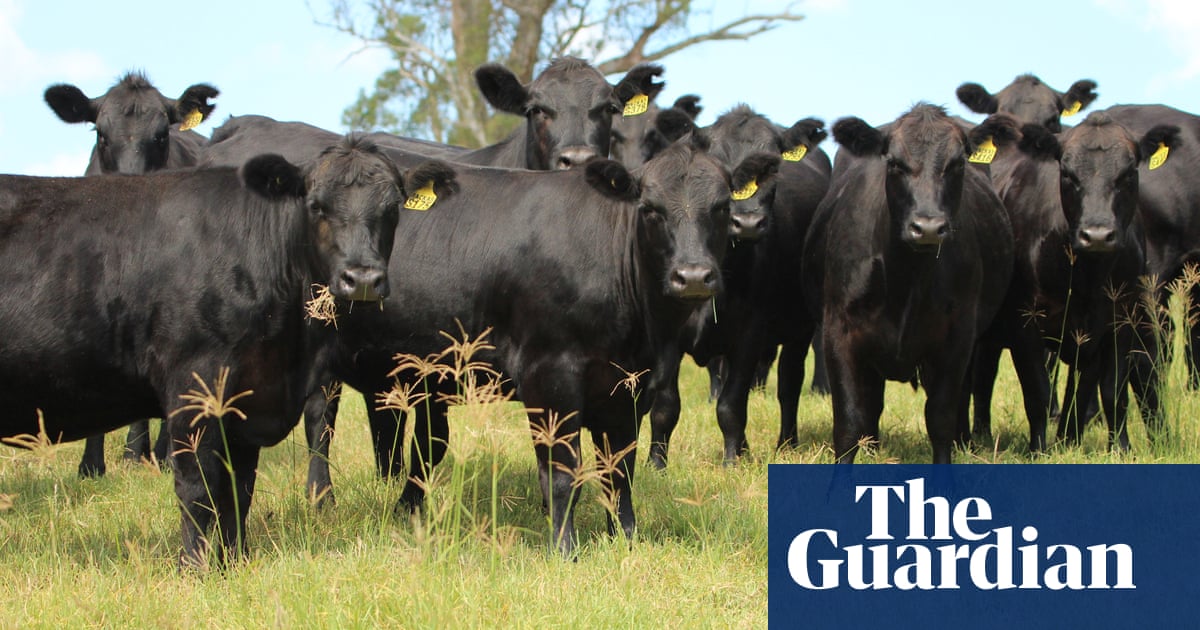Australiaâs first carbon-neutral cattle sale took place this week.
Seven hundred Angus breeding cows and heifers, reared through a âcarbon-neutral farming systemâ, went under the hammer at the saleyards in Gloucester, a small town three hoursâ drive from Sydney, on Thursday.
In theory, every cow at the auction has released net zero greenhouse gas emissions from birth to sale day, because the farm has sequestered more carbon than the cattle released.
The cattle were bred by fourth-generation farmer Robert MacKenzie.
âIâm doing it for my family and to show farmers this is achievable,â he said. âI have two sons that will eventually take on the business ⦠they are part of a generation where sustainability matters.â
For Australiaâs red meat industry, which has set a sector-wide net zero emissions goal by 2030, the sale is an important proof of concept: is producing net zero cattle worth the cost?
How can a live cow be carbon neutral?
Well, the individual animal is still making its natural emissions. But it can, theoretically, be embedded within a supply chain that achieves carbon neutrality.
Mackenzieâs cattle operation, Mackaâs Pastrol, uses soil carbon sequestration to offset their greenhouse gas emissions, which includes methane released by cattle as well as vehicles and electricity generation.
In 2022, it employed agronomy consultant Agricore to take soil carbon samples across its 6,500ha holdings.
The farm then implemented new management practices including intensive stock rotation, planting a more diverse mix of grass species and targeted organic fertiliser use, which is intended to improve landscape health, boost productivity and increase soil carbon.
In 2023, another 1,400 soil samples were taken, showing a 40% average increase in soil carbon, at 540kg Co2 sequestered per hectare. The 2024 results are pending. According to Agricore, this meant the farm had stored more carbon in the ground than the total emissions released by the farm over the same year.
This carbon accounting approach is known as âinsettingâ, where on-farm carbon sequestration is counted against the farmâs operational emissions to reach net zero.
How do you get a farm to net zero?
The director of Agricore, Hayden Hollis, said annual soil carbon tests across Mackenzieâs farm were conducted in accordance with Clean Energy Regulator (CER) guidelines. While the regulatorâs methodology is widely used by the industry, a consortium of Australian soil scientists have called for flaws in the scheme to be âaddressed as a matter of urgencyâ.
Agricoreâs data is proprietary and could not be viewed by Guardian Australia.
One of those scientists is Dr Elaine Mitchell from the Queensland University of Technology. She says intervals of at least five years are usually required to detect statistically significant soil carbon changes.
Prof Richard Eckard, an agricultural economist from the University of Melbourne, said soil carbon should be measured on a 10-year running mean to account for seasonal fluctuations, 70% of which is driven by rainfall patterns.
He said success could not be determined until âyou have ironed out the rainfall variability and reflect what is truly managementâ.
The margin of error in sampling was about 20%, Eckard said, with another 10% variation in laboratory analysis. âAnnual changes in soil carbon are just buried in the noise of error in our ability to measure soil carbon.â
after newsletter promotion
Can soil carbon sequestration mitigate livestock emissions?
Pastures have the potential to store huge amounts of carbon, but these gains are by no means permanent and slow overtime.
Like Mackaâs Pastoral, Jigsaw Farms in western Victoria inset its livestock emissions to achieve carbon neutrality, but this was only possible for about seven years.
Hollis said Mackenzieâs soil carbon project was in its infancy and would continue to see soil carbon gains. âBut like any landscape, there comes a point where we hit capacity,â he said. âUnfortunately thatâs just the reality of it.â
Once that occurs, Hollis said, the farm would have to find other ways of insetting or reducing its livestock emissions, such as tree plantings and breeding for faster-growing cattle.
A global study led by Wageningen University in the Netherlands found that under right conditions â like the high rainfall area where Mackaâs Pastoral is based â short-term data suggests carbon sequestration can be used to mitigate the grazing system emissions.
But it found that over the long term, it is âoverly optimistic and could be misleadingâ and âhas a limited role to mitigate climate warmingâ.
Farmers also have the option of using carbon gains to obtain Australian carbon credit units (ACCUs) through the CER with the help of a âcarbon developerâ. These credits can then be sold and bought by large polluters as offsets to their own Co2 emissions, or used to inset on-farm emissions and become certified carbon neutral by the governmentâs Climate Active program.
There are now 528 soil carbon projects registered under the ACCU scheme, which has received criticism from scientists. So far seven have been issued credits.
Whatâs the market for carbon-neutral cattle?
Coles supermarket stocks a small range of carbon-neutral beef and pork bought directly from producers including Jigsaw Farms, which receive a premium price for their cattle. But the sale at Gloucester is the first public cattle auction marketed by a vendor as carbon neutral.
Wynand Snyman, the chief executive of Auctions Plus, the online livestock marketplace that hosted the sale, said livestock emissions reporting was in its infancy.
The average price across the sale was $1,753 and the highest price, for heifers pregnancy tested in calf, was $4,300. But buyers were largely attracted to the cattleâs genetics, not their carbon footprint.
Farmer Bill McDonald bought 13 of Mckenzieâs cows. âThey were good cattle with good genetics at the end of the day,â he said. âAnd Iâm working towards being carbon neutral too, so thatâs a bonus.â












